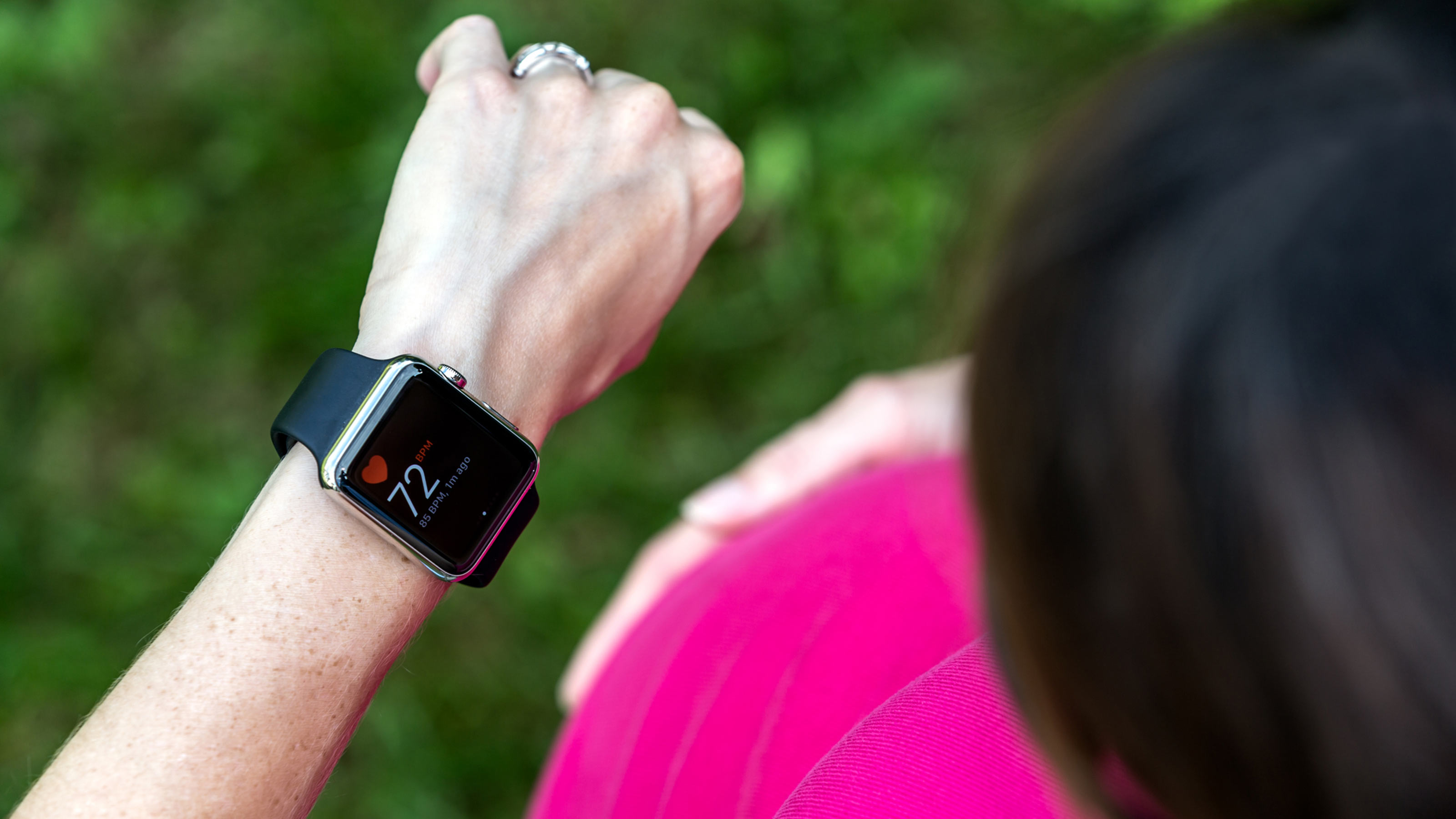High-Tech Aids for Aging in Place
Apple Watch and other technology provides fast feedback, comfort for older users, and a powerful assist for caregivers.

Heidi Wilson, 69, loves to watch British television shows with her husband, but the accents and her hearing impairment made it difficult to catch all the dialogue. “I was always interrupting to ask him to repeat what the characters said or to turn up the volume,” she says in an email.
Then several months ago, Wilson, a retired lawyer in Wayzata, Minn., got a pair of Starkey Livio Edge AI hearing aids that she controls with her smartphone. An app helps her filter out background noise and adjust volume to hear better.
“Now I usually hear the accents well enough to understand, and if I can’t, I use the app to turn up the volume,” she says.
From just $107.88 $24.99 for Kiplinger Personal Finance
Become a smarter, better informed investor. Subscribe from just $107.88 $24.99, plus get up to 4 Special Issues

Sign up for Kiplinger’s Free Newsletters
Profit and prosper with the best of expert advice on investing, taxes, retirement, personal finance and more - straight to your e-mail.
Profit and prosper with the best of expert advice - straight to your e-mail.
For older adults willing to embrace it, wireless technology is a game changer, making a bevy of sophisticated products—from smartphone-managed hearing aids to home sensors that communicate with distant caregivers—possible. In many cases, the technology is helping older adults live independently at home longer, with baby boomers a rich consumer market for the devices. Boomers are interested in the technology not only to improve their own quality of life but also to help care for elderly parents, who are just as adamant about remaining in their own homes.
Technology, of course, is no substitute for human caregivers, but it can stretch a budget for in-home care with remote monitoring and other safety devices.
“They don’t replace the capabilities you get in assisted living,” says Laurie Orlov, principal analyst with Aging and Health Technology Watch in Port St. Lucie, Fla. But “some of these technologies can be useful for people who cannot afford $4,000 a month.”
The six products that follow are a sampling of the range of devices, some of which are tied to subscription services or may only be obtained through a third party, like a physician or home care agency.
■ Apple Watch Series 6 ($399). Think of this digital wristwatch, which has a built-in electrocardiogram, as a ticker for your ticker. The watch’s ECG feature has Food and Drug Administration approval and monitors a person’s heartbeat for irregularities, like those associated with atrial fibrillation. Users hold their finger to a sensor on the watch to get a reading.
The ECG feature needs an iPhone 6s or later to work and a health app that can be downloaded free. The ECG results can be saved or shared with a doctor.
The watch also detects falls and automatically dials 911 if the wearer is unresponsive after 60 seconds.
■ MedMinder ($49.99 per month for pillbox rental and refill service). At first glance, this pill dispenser looks like any other, with 28 compartments for medication dosages organized by day of the week for one to four weeks of medications. A MedMinder pharmacist fills the prescriptions with customized trays that slide into the dispenser to match the user’s medication schedule. Flashing lights, beeps, phone calls or text messages remind users it’s time to take the pills.
Refill trays are automatically mailed to the recipient; five or more prescription medications are needed for the monthly refill service. MedMinder works with most insurers, including many Medicare Part D plans, and requires a cellphone or WiFi connection.
■ Starkey Livio Edge AI hearing aids ($5,000-$6,500 per pair including audiologist service). Using an app and a smartphone, these rechargeable hearing aids customize sound for the wearer. In “edge” mode, the hearing aid isolates certain sounds, like a companion’s voice, so that users can hear better in noisy settings like restaurants. The app also streams phone calls, music, podcasts and audio books directly to the hearing aid.
The hearing aids come with a fitness app and use artificial intelligence to monitor a person’s activity level and detect falls. Starkey Livios are only available through an audiologist who tests the user’s hearing and fits the device. Most insurers and traditional Medicare don’t cover hearing aids or exams for adults, though some Advantage plans do as an extra benefit.
■ True Link Prepaid Visa Card ($10 per month). This customizable debit card and subscription service offers older adults with a mild cognitive disability some financial freedom for ordinary daily purchases at a coffee shop or grocery store while alerting caregivers to big expenditures. The card is linked to an existing bank account for recurring transfers. A trusted family member sets the amount for triggering an alert and selects criteria for blocking payments, such as those to telemarketers, charities and TV shopping. The alerts can be sent to more than one person.
“You have situations like two sisters; one of them wants to keep an eye on mom and the other wants to keep an eye on the sister,” says True Link’s CEO Kai Stinchcombe.
■ SmartSole ($299 for insoles and $24.98 monthly subscription). Keeping track of a loved one with dementia who wanders off and gets lost is a full-time job that typically falls to family members. More than 5.8 million Americans suffer from Alzheimer’s, the most common type of dementia, according to the Alzheimer’s Association.
With built-in GPS, this smart insole fits inside most shoes to make tracking the person easier from any computer, tablet or smartphone. The device pinpoints the person’s whereabouts on a map, supplying addresses and outdoor locations to within 15 feet every five minutes.
The SmartSole uses a small rechargeable 2G cellphone-style battery and generally lasts one or two days on a single charge. The product works in connection with a monthly subscription monitoring service.
■ envoyatHome ($99 to $399 per month depending on agency and level of monitoring; installation may be separate). This remote caregiving service was designed for older adults who can’t afford a full-time health aide and live alone, like envoyatHome CEO Rob Blatt’s mom. Newly widowed, she was living in another state when Blatt, an engineer, devised the service that later became envoyatHome.
There are no cameras, but the service uses smart-home sensors and is purchased through a partnering home care agency to monitor the person’s wellness and safety. Reports and alerts are issued in real time so that remote caregivers can close a forgotten garage door or check if a home health aide is rifling through a drawer where valuables are kept. The sensors also monitor activity that can help spot health issues. One customer’s frequent trips to the bathroom led to a diagnosis of a urinary tract infection.
Profit and prosper with the best of Kiplinger's advice on investing, taxes, retirement, personal finance and much more. Delivered daily. Enter your email in the box and click Sign Me Up.
Siskos is an old hat with the Kiplinger brand. More than a decade ago, she spent eight years writing about personal finance for Kiplinger's Personal Finance magazine, including a monthly column—Starting Out—that served young adults. That was in her salad days. Now she's turned her attention to an audience she hopes to join in a decade or so: retirees. Siskos is the managing editor for Kiplinger's Retirement Report. In between, she broadened her personal-finance repertoire with real estate and investing stories at Old-House Journal, Investing Daily and U.S. News. She comes to Kiplinger by way of the Newseum, where she worked as an exhibit editor.
-
 AI Stocks Lead Nasdaq's 398-Point Nosedive: Stock Market Today
AI Stocks Lead Nasdaq's 398-Point Nosedive: Stock Market TodayThe major stock market indexes do not yet reflect the bullish tendencies of sector rotation and broadening participation.
-
 Top Tech Gifts to Grab at Walmart Before Christmas
Top Tech Gifts to Grab at Walmart Before ChristmasBig savings on Apple, Bose, HP, Vizio and more while there's still time to shop.
-
 AI Appliances Aren’t Exciting Buyers…Yet
AI Appliances Aren’t Exciting Buyers…YetThe Kiplinger Letter Artificial intelligence is being embedded into all sorts of appliances. Now sellers need to get customers to care about AI-powered laundry.
-
 21 Last-Minute Gifts for Grandparents Day 2025 to Give Right Now
21 Last-Minute Gifts for Grandparents Day 2025 to Give Right NowHoliday Tips Last-minute gifting is never easy. But here are some ideas to celebrate Grandparents Day.
-
 Texas Sales Tax-Free Weekend 2025
Texas Sales Tax-Free Weekend 2025Tax Holiday Here's what you needed to know about the Texas sales tax holiday.
-
 Alabama Tax-Free Weekend 2025
Alabama Tax-Free Weekend 2025Tax Holiday Here’s everything you need to know about the 2025 back-to-school Alabama sales tax holiday.
-
 Amazon Resale: Where Amazon Prime Returns Become Your Online Bargains
Amazon Resale: Where Amazon Prime Returns Become Your Online BargainsFeature Amazon Resale products may have some imperfections, but that often leads to wildly discounted prices.
-
 457 Plan Contribution Limits for 2026
457 Plan Contribution Limits for 2026Retirement plans There are higher 457 plan contribution limits in 2026. That's good news for state and local government employees.
-
 The Sweet 23: States Where Twix and Kit Kat Avoid the ‘Candy Tax’
The Sweet 23: States Where Twix and Kit Kat Avoid the ‘Candy Tax’State Taxes There’s something spooky this Halloween, and it’s not just the ghouls. Find out if your state’s sales tax takes a bite out of sweet savings.
-
 Florida Back-to-School Tax-Free Holiday 2025
Florida Back-to-School Tax-Free Holiday 2025Sales Taxes The new tax-free holiday in Florida brought month-long savings on computers, clothing and other school supplies.
-
 Medicare Basics: 12 Things You Need to Know
Medicare Basics: 12 Things You Need to KnowMedicare There's Medicare Part A, Part B, Part D, Medigap plans, Medicare Advantage plans and so on. We sort out the confusion about signing up for Medicare — and much more.